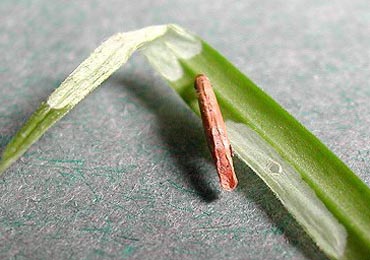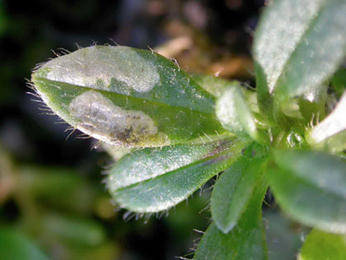|
||||||
|
ARENARIA. Sandworts. [Caryophyllaceae] |
|
Fringed Sandwort (A. ciliata), Arctic Sandwort (A. norvegica norvegica), English Sandwort (A. norvegica anglica), Slender Sandwort (A. serpyllifolia leptoclados) and Thyme-leaved Sandwort (A. serpyllifolia serpyllifolia) are native to Britain. Mossy Sandwort (A. balearica) and Large-flowered Sandwort (A. montana) have been intorduced. The BSBI provide a downloadable plant crib for Arenaria. Arctic or Norwegian Sandwort (A. norvegica) is protected under Schedule 8 of the Wildlife and Countryside Act, 1981. Six British miners are recorded on Arenaria. A key to the European miners recorded on Arenaria is provided in Bladmineerders van Europa. |
Key for the identification of the known mines of British |
1a > Leaf-miner and case-bearer: The larva lives outside the mine, protected by a case, and feeds on the underlying plant tissues via a hole cut in the epidermis. From that point it eats away as much leaf tissue as it can reach without fully entering the mine. Mine does not contain frass. In autumn the larva makes a short corridor, that widens into a small blotch, out of which the first case is cut. The final case, after hibernation, is a brown, tubular silken case, three-valved, c. 6 cm long, with a mouth angle of about 30°. |
|
Coleophora chalcogrammella Zeller, 1839 [Lepidoptera: Coleophoridae]. |
1b > Leaf-miner and case-bearer: The larva lives outside the mine, protected by a case, and feeds on the underlying plant tissues via a hole cut in the epidermis. From that point it eats away as much leaf tissue as it can reach without fully entering the mine. Mine does not contain frass. Larva mines leaves of Caryophyllaceae. The final case is tubular, 8 mm long, with a dorsal keel which forks and continues as two ridges to the anal end of the case. The larval case is very distinctive when fully grown as it is a pale pink colour and has a double dorsal keel. Larva in a trivalved tubular silken case of 8 mm long, with a mouth angle of 25°-30°. The case is pale brown. A unique detail is the presence of a double dorsal keel, but this only occurs when the larva is fully developed: the foremost part of the keel remains single, but already the fork appears before the middle. |
 Case and mine of Coleophora lithargyrinella on Stellaria holostea Image: © Rob Edmunds (British leafminers) |
|
Coleophora lithargyrinella Zeller, 1849 [Lepidoptera: Coleophoridae]. |
1c > Leaf-miner and case-bearer: The larva lives outside the mine, protected by a case, and feeds on the underlying plant tissues via a hole cut in the epidermis. From that point it eats away as much leaf tissue as it can reach without fully entering the mine. Mine does not contain frass. Larva mines leaves, forming a case from an excised mine. This case is later extended, and widened by slitting the ventral side to insert a gusset. The full-grown case is 8 mm long with a single ventral keel. Full grown larva in a slender greyish white three-valved tubular silken case of c. 8 mm; mouth angle about 45°. Often several cases together on a small number of plants. |
|
Coleophora solitariella Zeller, 1849 [Lepidoptera: Coleophoridae]. |
1d > Leaf-miner, but not a case bearer |
2a > Leaf and stem miner: Eggs are scattered individually over the leaf upper surface; they are only loosely attached to the plant. The egg shell has a honeycomb structure. The larva begins with first mining one of the top leaves completely out. Next the larva moves down to another leaf, by way of a tunnel made in the stem. In this way several leaves are mined out, completely and full depth. In the attacked part of the plant the stem has become translucent; the damage causes the plant tip to wilt. In the first mines almost no frass is to be found, further down it is deposited in coarse grains. Pupation generally outside the mine (Miles, 1953). |
|
Delia echinata (Seguy, 1923) [Diptera: Anthomyiidae]. |
2b > Leaf-miner: The mine starts as a long, narrow, winding corridor running towards the midrib, widening to a blotch. Usually upper-surface, but in small leaves also full-depth parts may occur. The blotch has broad lobes; in their ends most frass is accumulated in the form of green patches or clouds. Sometimes several larvae share mine. Pupation usually in the soil, less often in the leaf (and then generally not in the mine itself but in a small separated mine, that may even be made in the petiole). |
 Mine of Scaptomyza graminum on Cerastium glomeratum Image: © Jean-Yves Baugnée (Bladmineerders van Europa) |
|
Scaptomyza graminum (Fallén, 1823) [Diptera: Drosophilidae]. |
2d > Leaf-miner: Initially mining the leaves, but later on spun flowers and seeds. |
|
Caryocolum alsinella (Zeller, 1868) [Lepidoptera: Gelechiidae]. |
| Last updated 30-Jun-2019 Brian Pitkin | ||
